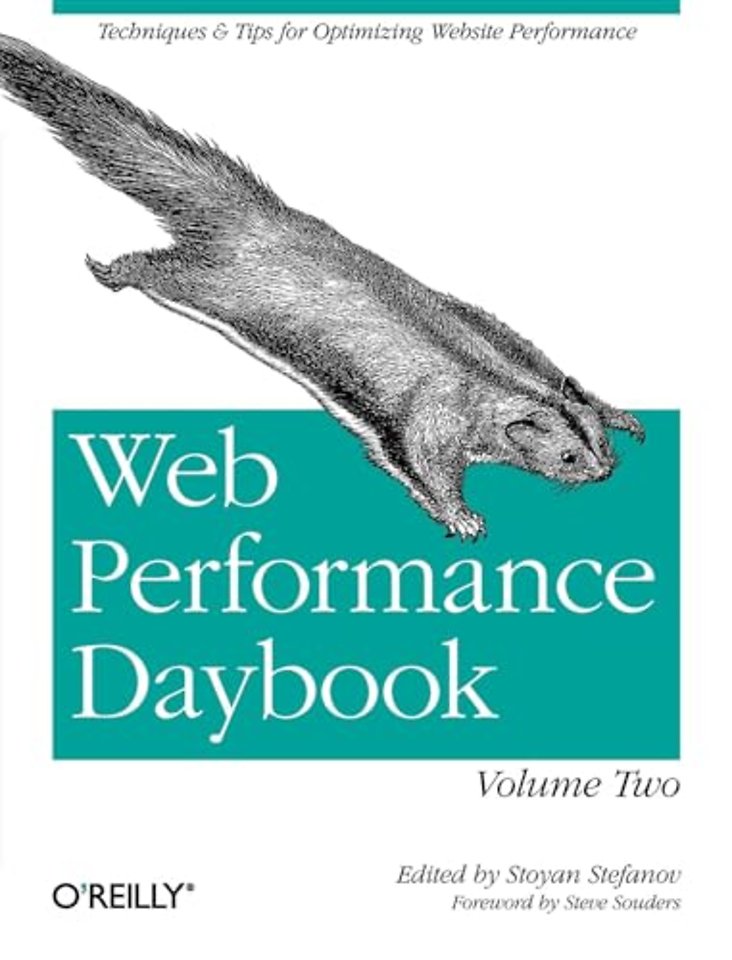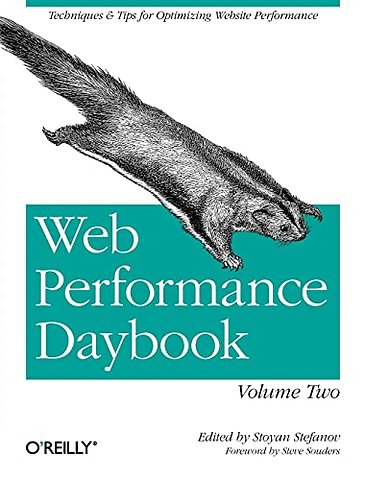Web Performance Daybook V2
Samenvatting
Performance is critical to the success of any website, and help with using today’s new tools is key. In this remarkable guide, 32 leading web performance experts offer practical tips, techniques, and advice for optimizing your site’s user experience.
Originally written for an online calendar, this collection of articles will inspire you to squeeze every ounce of performance from your site—whether you’re a web developer, mobile developer, or web designer. Check the table of contents and you’ll be convinced.
In order of appearance, Web Performance Daybook authors include:Patrick MeenanNicholas ZakasGuy PodjarnyStoyan StefanovTim KadlecBrian PaneJosh FraserSteve SoudersBetty TsoIsrael NirMarcel DuranÉric DaspetAlois ReitbauerMatthew PrinceBuddy BrewerAlexander PodelkoEstelle WeylAaron PetersTony GentilcoreMatthew SteeleBryan McQuadeTobie LangelBilly HoffmanJoshua BixbySergey ChernyshevJP CastroPavel PaulauDavid CalhounNicole SullivanJames PearceTom Hughes-CroucherDave Artz
Specificaties
Inhoudsopgave
From the Editor;
About the Authors;
Patrick Meenan;
Nicholas Zakas;
Guy Podjarny;
Stoyan Stefanov;
Tim Kadlec;
Brian Pane;
Josh Fraser;
Steve Souders;
Betty Tso;
Israel Nir;
Marcel Duran;
Éric Daspet;
Alois Reitbauer;
Matthew Prince;
Buddy Brewer;
Alexander Podelko;
Estelle Weyl;
Aaron Peters;
Tony Gentilcore;
Matthew Steele;
Bryan McQuade;
Tobie Langel;
Billy Hoffman;
Joshua Bixby;
Sergey Chernyshev;
JP Castro;
Pavel Paulau;
David Calhoun;
Nicole Sullivan;
James Pearce;
Tom Hughes-Croucher;
Dave Artz;
Preface;
Conventions Used in This Book;
Using Code Examples;
Safari® Books Online;
How to Contact Us;
Chapter 1: WebPagetest Internals;
1.1 Function Interception;
1.2 Code Injection;
1.3 Resulting Browser Architecture;
1.4 Get the Code;
1.5 Browser Advancements;
Chapter 2: localStorage Read Performance;
2.1 The Benchmark;
2.2 What’s Going On?;
2.3 Optimization Strategy;
2.4 Follow Up;
Chapter 3: Why Inlining Everything Is NOT the Answer;
3.1 No Browser Caching;
3.2 No Edge Caching;
3.3 No Loading On-Demand;
3.4 Invalidates Browser Look-Ahead;
3.5 Flawed Solution: Inline Everything only on First Visit;
3.6 Summary and Recommendations;
Chapter 4: The Art and Craft of the Async Snippet;
4.1 The Facebook Plug-ins JS SDK;
4.2 Design Goals;
4.3 The Snippet;
4.4 Appending Alternatives;
4.5 Whew!;
4.6 What’s Missing?;
4.7 First Parties;
4.8 Parting Words: On the Shoulders of Giants;
Chapter 5: Carrier Networks: Down the Rabbit Hole;
5.1 Variability;
5.2 Latency;
5.3 Transcoding;
5.4 Gold in Them There Hills;
5.5 4G Won’t Save Us;
5.6 Where Do We Go from Here?;
5.7 Light at the End of the Tunnel;
Chapter 6: The Need for Parallelism in HTTP;
6.1 Introduction: Falling Down the Stairs;
6.2 Current Best Practices: Working around HTTP;
6.3 Experiment: Mining the HTTP Archive;
6.4 Results: Serialization Abounds;
6.5 Recommendations: Time to Fix the Protocols;
Chapter 7: Automating Website Performance;
Chapter 8: Frontend SPOF in Beijing;
8.1 Business Insider;
8.2 CNET;
8.3 O’Reilly Radar;
8.4 The Cause of Frontend SPOF;
8.5 Avoiding Frontend SPOF;
8.6 Call to Action;
Chapter 9: All about YSlow;
Chapter 10: Secrets of High Performance Native Mobile Applications;
10.1 Keep an Eye on Your Waterfalls;
10.2 Compress Those Resources;
10.3 Don’t Download the Same Content Twice;
10.4 Can Too Much Adriana Lima Slow You Down?;
10.5 Epilogue;
Chapter 11: Pure CSS3 Images? Hmm, Maybe Later;
11.1 The Challenge;
11.2 Getting My Hands Dirty with CSS3 Cooking;
11.3 Cross-Browser Results;
11.4 Benchmarking;
11.5 Are We There Yet?;
11.6 Appendix: Code Listings;
Chapter 12: Useless Downloads of Background Images in Android;
12.1 The Android Problem;
12.2 And the Lack of Solution;
Chapter 13: Timing the Web;
13.1 Conclusion;
Chapter 14: I See HTTP;
14.1 icy;
14.2 Some details;
14.3 Walkthrough;
14.4 Todos;
14.5 The Road Ahead;
14.6 All I Want for Christmas…;
Chapter 15: Using Intelligent Caching to Avoid the Bot Performance Tax;
Chapter 16: A Practical Guide to the Navigation Timing API;
16.1 Why You Should Care;
16.2 Collecting Navigation Timing Timestamps and Turning Them into Useful Measurements;
16.3 Using Google Analytics as a Performance Data Warehouse;
16.4 Reporting on Performance in Google Analytics;
16.5 Limitations;
16.6 Final Thoughts;
Chapter 17: How Response Times Impact Business;
Chapter 18: Mobile UI Performance Considerations;
18.1 Battery Life;
18.2 Latency;
18.3 Embedding CSS and JS: A Best Practice?;
18.4 Memory;
18.5 UI Responsiveness;
18.6 Summary;
Chapter 19: Stop Wasting Your Time Using the Google Analytics Site Speed Report;
19.1 Problem: A Bug in Firefox Implementation of the Navigation Timing API;
19.2 Solution: Filter Out the Firefox Timings in Google Analytics;
19.3 Good News: The Bug Was Fixed in Firefox 9;
19.4 Closing Remark;
Chapter 20: Beyond Web Developer Tools: Strace;
20.1 What About Other Platforms?;
20.2 Getting Started;
20.3 Zeroing In;
20.4 Example: Local Storage;
20.5 We’ve Only Scratched the Surface;
Chapter 21: Introducing mod_spdy: A SPDY Module for the Apache HTTP Server;
21.1 Getting Started with mod_spdy;
21.2 SPDY and Apache;
21.3 Help to Improve mod_spdy;
Chapter 22: Lazy Evaluation of CommonJS Modules;
22.1 Close Encounters of the Text/JavaScript Type;
22.2 Lazy Loading;
22.3 Lazy Evaluation to the Rescue;
22.4 Building Lazy Evaluation into CommonJS Modules;
Chapter 23: Advice on Trusting Advice;
Chapter 24: Why You’re Probably Reading Your Performance Measurement Results Wrong (At Least You’re in Good Company);
24.1 The Methodology;
24.2 The Results;
24.3 Conclusions;
24.4 Why Does This Matter?;
24.5 Takeaways;
Chapter 25: Lossy Image Compression;
25.1 Lossy Compression;
Chapter 26: Performance Testing with Selenium and JavaScript;
26.1 Recording Data;
26.2 Collecting and Analyzing the Data;
26.3 Sample Results;
26.4 Benefits;
26.5 Closing Words;
26.6 Credits;
Chapter 27: A Simple Way to Measure Website Performance;
27.1 Concept;
27.2 Advantages;
27.3 Limitation;
27.4 Conclusion;
Chapter 28: Beyond Bandwidth: UI Performance;
28.1 Introduction;
28.2 After the Page Loads: The UI Layer;
28.3 UI Profilers;
28.4 Perception of Speed;
28.5 Tidbits;
28.6 Call for a Focus on UI Performance;
Chapter 29: CSS Selector Performance Has Changed! (For the Better);
29.1 Style Sharing;
29.2 Rule Hashes;
29.3 Ancestor Filters;
29.4 Fast Path;
29.5 What Is It Still Slow?;
Chapter 30: Losing Your Head with PhantomJS and confess.js;
30.1 Performance Summaries;
30.2 App Cache Manifest;
30.3 Onward and Upward;
Chapter 31: Measure Twice, Cut Once;
31.1 Identifying Pages/Sections;
31.2 Identifying Features;
31.3 Optimizing;
Chapter 32: When Good Backends Go Bad;
32.1 What Is a Good Backend Time?;
32.2 Figuring Out What Is Going On;
32.3 Fixing It;
32.4 Finally;
Chapter 33: Web Font Performance: Weighing @font-face Options and Alternatives;
33.1 Font Hosting Services Versus Rolling Your Own;
33.2 What the FOUT?;
33.3 Removing Excess Font Glyphs;
33.4 JavaScript Font Loaders;
33.5 Gentlefonts, Start Your Engines!;
33.6 Final Thoughts;
Colophon;
Net verschenen
Rubrieken
- aanbestedingsrecht
- aansprakelijkheids- en verzekeringsrecht
- accountancy
- algemeen juridisch
- arbeidsrecht
- bank- en effectenrecht
- bestuursrecht
- bouwrecht
- burgerlijk recht en procesrecht
- europees-internationaal recht
- fiscaal recht
- gezondheidsrecht
- insolventierecht
- intellectuele eigendom en ict-recht
- management
- mens en maatschappij
- milieu- en omgevingsrecht
- notarieel recht
- ondernemingsrecht
- pensioenrecht
- personen- en familierecht
- sociale zekerheidsrecht
- staatsrecht
- strafrecht en criminologie
- vastgoed- en huurrecht
- vreemdelingenrecht

